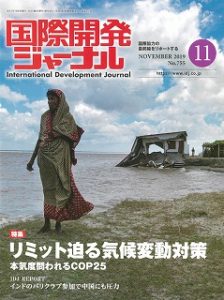Participation in the Paris Club of India pressures China
IDJ ENGLISH
『International Development Journal』 2019 November edition
IDJ-Report
Despite being included in the Summit Declaration at the G20 Osaka Summit held in June of 2019, there were issues barely reported in the mass media. They include an expansion of the membership of the Paris Club, the public debt consulting organization. There is also a glimpse of the medium- to long-term strategy of developed countries including Japan, the US and Europe which want to make all BRICS, including emerging donors China and India, permanent members of the Paris Club.
India’s participation strongly welcomed
The Paris Club is an informal organization that discusses the rescheduling and reduction of public debt to help debtor countries. It was originally named in 1956 when Argentina’s debt negotiations began with creditors gathering at the French Ministry of Finance. It is a loose, informal framework. Permanent members include 21 countries that are members of the Organization for Economic Co-operation and Development (OECD) including Japan, the United States, Europe and Russia.
There are also associate members (ad hoc participating countries) such as China, Turkey, Saudi Arabia and South Africa, who can attend at any time with the approval of the permanent members and the debtor countries. In addition, the International Monetary Fund (IMF), the World Bank, the Asian Development Bank (ADB), and the OECD Secretariat also attended as observers. The G20 Osaka Summit Declaration, adopted on June 29, stated, “We support the ongoing work of the Paris Club, as the principal international forum for restructuring official bilateral debt, towards the broader engagement of emerging creditors and we welcome India associating voluntarily with the Paris Club to cooperate in its work on a case-by-case basis.”
Expanding economic cooperation with Africa
Behind India’s participation is the expansion of “South-South cooperation” with other developing countries. Looking at the history of economic assistance in India, we have mainly supported human resource development in neighboring countries in South Asia, centered on the “India Technology and Economic Cooperation Program (ITEC)” launched in 1964. But what has been growing in recent years is the financing of the import and export bank, a government-affiliated financial institution. In 2014, India provided 194 projects in 63 countries, totaling $ 11.7 billion, according to a report from the German Institute for International Security (SWP). Of that amount, $ 6.6 billion was for Africa. 58% of total funding for the past 10 years since fiscal 2006 is for Africa. According to reports, Ghana and Swaziland have supported the construction of the Parliament Buildings, and have also announced cooperation in the construction of conference centers in 21 African and other countries, including Niger. It seems to follow the Chinese way. India has also established the India-Africa Forum Summit (IAFS) since 2008, taking into account Japan and China’s African cooperation. In 2017, India invited and held a meeting of the African Development Bank (AfDB) in Gujarat, home of Prime Minister Narendra Modi. At that time, in collaboration with Japan, the “Asia-Africa Growth Corridor (AAGC)” was launched.
Indian companies are also actively expanding. Approximately 140 Indian companies, including IT and automotive, have entered the South African country alone and have invested more than $ 4 billion. Moving forward, the company will accelerate its entry into Africa with a view to the common market of the African Continental Free Trade Area (AfCFTA), which went into effect in May.
Growing Debts of African Countries
On the other hand, according to Yoshino Takeyama, a researcher at the Institute for International Monetary Affairs, the public debt balance of sub-Saharan African countries has increased from 31.6% of GDP in 2013 to 49.1% in 2018. The percentage of foreign currencies has increased by more than half. The public debt to GDP ratio of 60% is considered a “danger zone,” but the ratio in Sub-Saharan Africa has been rising since the Lehman Crisis in 2008. According to Sayuri Shirai, a professor at Keio University, Zambia, that has abundant metal resources, is seeing increased external debt and increasing involvement of the IMF.
India’s decision to join the Paris Club is thought to strengthen its active involvement in the African market and hedge the risk of public debt. Brazil and Russia are permanent members of the Paris Club, and China and South Africa are also associate members, so it is possible for all five emerging BRICS countries to participate. However, there are significant differences between permanent members and associate members. Permanent members are able to take the lead in debt relief and have the advantage of maintaining their own debts, but as a prerequisite, they have to disclose full information on development cooperation.
Many of the permanent members, other than Russia, have joined the OECD and are also on the Development Assistance Committee (DAC), which sets the rules for aid. Russia joined the Paris Club in 1997 and is cooperating with developed countries in development cooperation.
“The Paris Club helps to reduce the risk of financial assistance to the former Soviet countries,” said Andrei Shelepov, Research Fellow at The Center for International Institutions Research, Russian Presidential Academy of National Economy and Public Administration (RANEPA). He participated in the Northeast Asian Development Forum held at the JICA Research Institute in Tokyo in September 2019. He said, “Russia has been sanctioned for Crimean issues and would have difficulty joining the OECD, but adheres to DAC rules.”
A Japanese government source involved in the G20 Finance Ministers and Central Bank Governors’ Meeting held in June 2019 says, “In the mid- to long-term, having India as an associate member has set BRICS as a starting point to become a permanent member of the Paris Club. For the time being, China will not join the OECD, which criticizes it as “a developed country village and it’s hard to imagine it ever joining. But the Paris Club is profitable and China could be a permanent member.”
Chinese scholars think “positive”
China has already shown a positive attitude toward the Paris Club at the 2016 G20 Hangzhou Summit. At the then-Leader’s Declaration, led by the Presidency of China, “we will play a more constructive role, including continued regular attendance at the Paris Club Meeting and further discussions on possible participation. We welcome China’s intention to do so.” In the year 2016, Korea and Brazil became permanent members of the Paris Club, and China incorporated RMB into the IMF’s Special Drawing Rights (SDR).
Professor Meibo Huang, Director of the Institute for International Development and Cooperation of Shanghai University of International Business and Economics, who participated in the Northeast Asian Development Forum, said, “There is a lively debate within the government about the membership of the Paris Club as a permanent member. I think there is an advantage and a possibility of membership in expanding development cooperation.” On the other hand, some observers state that “China has more than 20 government agencies with development cooperation budget and it will take time to disclose a large amount of information”, said Xiaomin Zhang, Associate Professor of Beijing Foreign Studies University. However, few voices have strongly refused their possible membership.
In the past, China has mainly pursued bilateral negotiations with debtor countries if there is a need for debt reduction and risk reduction. But if China joins the Paris Club, developing countries will also have an advantage in debt processing.
The DAC of OECD is conducting dialogue with China over development cooperation. It is necessary to focus on China’s response to the Paris Club in the future.
editor:Yukifumi Takeuchi
*****以下、日本語原文*****
インドのパリクラブ参加で中国にも圧力
G20大阪サミット首脳宣言で報じられなかった論点
2019年6月に開かれたG20大阪サミットで首脳宣言に盛り込まれたにもかかわらず、マスメディアでほとんど報道されなかった論点がある。公的債務の協議組織であるパリクラブの加盟国拡大である。新興ドナーの中国、インドを含むBRICS全部を恒久メンバーとして加盟させていきたい日本など先進国側の中長期戦略も垣間見える。
「インドの参加を歓迎」
パリクラブは債務国の救済のため、公的債務の繰り延べ(リスケ)や削減について協議する非公式な組織だ。もともと1956年に、アルゼンチンの債務問題協議に債権国がフランス財務省に集まって発足したため、この名がついた。緩やかな非公式の枠組みである。 恒久メンバーとしては、日米欧など経済協力開発機構(OECD)加盟の21カ国とロシアが入っている。さらに恒久メンバーと債務国の了解を得て随時、出席する準メンバー(アドホック参加国)がある。中国、トルコ、サウジアラビア、南アフリカなどだ。さらに国際通貨基金(IMF)、世界銀行、アジア開発銀行(ADB)、OECD事務局などがオブザーバー参加している。
6月29日に採択されたG20大阪サミット首脳宣言では、「二国間の公的債務を再編するための主要な国際フォーラムとして、債権者たる新興国のより多くの参加に向けてパリクラブが進めている取組を支持する」と、その役割を評価した。その上で「我々は、パリクラブと協働するために、インドがパリクラブに事案に応じた参加を自発的に決定したことを歓迎する」とし、インドがアドホック参加国となることを明らかにした。
拡大する対アフリカ経済協力
インドの参加の背景には、他の開発途上国に対する“南南協力”の拡大がある。 インドの経済援助の歴史を見ると、1964年に発足した「インド技術経済協力プログラム(ITEC)」を中心に、南アジアの隣国などで主に人づくり支援をしてきた。だが、近年伸びているのは、政府系金融機関である輸出入銀行の融資などだ。ドイツ国際安全保障研究所(SWP)の調査報告によると、インドは2014年度、世界63カ国に194件、総額117億ドルの資金協力を実施した。このうち66億ドルがアフリカ向けだった。2006年度から10年間の資金協力累計でも58%がアフリカ向けだ。
報道によると、ガーナやスワジランドでは国会議事堂建設を支援し、ニジェールなどアフリカ21カ国の会議場建設の協力も表明した。何やら中国のやり方を踏襲しているように見える。インドは日本や中国のアフリカ協力も参考に、2008年から「インド・アフリカ・フォーラム首脳会議(IAFS)」を定例化した。2017年にはナレンドラ・モディ首相の出身地、グジャラート州でアフリカ開発銀行(AfDB)の総会を誘致、開催した。その際、日本と連携で「アジア・アフリカ成長回廊(AAGC)」構想も打ち上げた。
インド企業の進出も活発だ。南アフリカ共和国だけでITや自動車などインド企業約140社が進出し、投資額は累計40億ドル以上に及ぶ。今後は、5月に発効した「アフリカ大陸自由貿易圏(AfCFTA)」の共通市場を視野に、アフリカ進出を一層加速させるだろう。
増加するアフリカ諸国の債務
一方、(公財)国際通貨研究所の竹山淑乃研究員によると、アフリカのサブサハラ諸国の公的債務残高は2013年のGDP比31.6%から2018年に同49.1%となり、内訳も外貨建ての割合が半分以上に拡大している。公的債務の対GDP比率は60%が「危険ゾーン」とされるが、サブサハラの同比率はリーマン危機の2008年以降、上昇し続けている。白井さゆり慶応大学教授によると、金属資源が豊かなザンビアも対外債務が増え、IMFの関与が強まっている。
インドのパリクラブ参加の判断は、自国のアフリカ市場への積極関与と公的債権のリスクヘッジを強める思惑と考えられる。パリクラブではブラジル、ロシアが恒久メンバーで、中国、南アも準メンバーであるため、新興大国BRICS全5カ国の参加が実現する形だ。
もっとも、恒久メンバーと準メンバーの立場は大きな差異がある。恒久メンバーなら債務救済を主導でき、自国の債権保全なども有利にできるが、その前提として開発協力に関する全面的な情報開示が迫られる。恒久メンバーのうち、ロシア以外は多くがOECDに加盟し、援助ルールを定める開発援助委員会(DAC)にも入っている。
そのロシアも1997年にパリクラブに加盟し、開発協力では先進国と協調を進めている。9月末に東京のJICA研究所で開かれた北東アジア開発フォーラムに参加したロシア政府系研究所、RANEPAのアンドレイ・シェレポフ研究員は「パリクラブは旧ソ連圏諸国への経済援助のリスク対策に役立つ。ロシアはクリミア問題で制裁され、OECD加盟は難しいが、DACルールは順守している」と述べた。
今年6月のG20財務相・中央銀行総裁会議(福岡市)、大阪サミットに関わった日本政府筋は言う。「インドを準メンバーに迎えたことで、中長期的にはBRICS全部がパリクラブの恒久メンバーになる出発点に立った。中国は『先進国村だ』と批判するOECDに加盟することは当面、考えにくいが、パリクラブなら実利があり、恒久メンバーとして加盟もありうる」
中国識者も「可能性ある」
その中国は既に2016年、G20杭州サミットでパリクラブに前向きな姿勢を示している。この時の議長国、中国が主導した首脳宣言で「我々は,中国のパリクラブ会合への継続した定期的な出席および、参加の可能性に関する更なる議論を含む、より建設的な役割を果たそうという中国の意図を歓迎する」との文言が盛り込まれた。
この年は韓国、ブラジルがパリクラブの恒久メンバーになり、中国はIMFの特別引出権(SDR)構成通貨に人民元が組み込まれた。
前述の北東アジア開発フォーラムに参加した上海対外経貿大学の国際発展合作研究院院長、黄梅波教授はこう言う。「パリクラブの恒久メンバーとしての加盟については、政府内で活発な議論になっている。開発協力を拡大する立場としては利点もあり、加盟の可能性はあると思う」と述べた。
その一方、「中国は開発協力予算が20以上の政府機関にわたっており、まとまった情報開示には時間がかかる」(北京外国語大学国際関係学院の張效民副教授)との見方もある。だが、加盟の可能性を強く否定する声は少なかった。また、中国は従来、債務削減やリスケの必要性があれば、債務国との二国間交渉で主に進めているが、中国がパリクラブに加盟すれば、途上国にも債務処理に利点がある。
開発協力をめぐる中国との対話はOECDのDACが進めている。中国のパリクラブへの今後の対応も、注視していくことが必要だ。
本誌編集委員:竹内幸史
『国際開発ジャーナル』2019年11月号掲載記事




